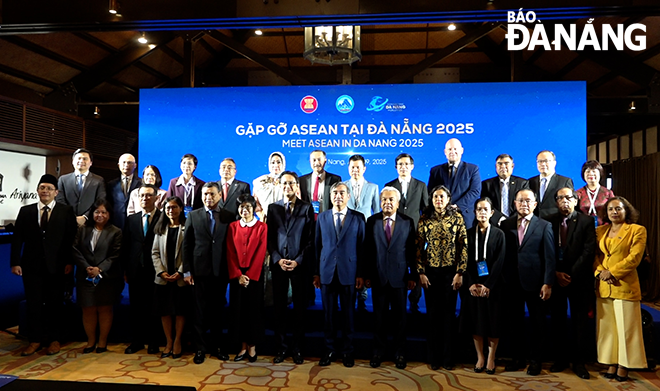Da Nang Port reaches far for more development strides
In order to affirm its stature and position as the most modern seaport in Central Viet Nam, and the country as a whole, recently, the Da Nang Port has pioneered comprehensive digital transformation, optimised production processes and speeded up the delivery process and improved productivity, thus contributing to the development of a strong marine economy to become a leading international trade gateway.
 |
| The Da Nang Port gradually affirms its position in all aspects, contributing to promoting the economic and tourism sectors of Da Nang and neighbouring provinces to increase significantly. Photo: H.T.V |
Productivity doubled
At the Da Nang Port, thousands of colourful containers stacked on top of each other, waiting for their owners to load them onto trucks marked in alphabetical order. Not only that, far out there, giant lifting cranes are busy loading and unloading goods from a cargo ship with a tonnage of thousands of tonnes docked at the port.
All employees are busy, coordinating smoothly, ensuring on-schedule implementation of assigned tasks. Because the seaport has a constant flow of container trucks, passengers and staff are not allowed to walk but use electric vehicles to ensure safety. The port operates around the lock, regardless of day or night, holidays or Tet. The port's busiest operating time is from 5:00 p.m. to 7:00 p.m.
At the entrance gate of the port, hundreds of container trucks lining up to pass through the gate and only stopping for about one minute for the automatic container gate (Autogate) to identify the container code using an algorithm.
ACCR combines artificial intelligence (AI), recognizes license plates and controls opening and closing, reads electronic scale indicators, uses RPA (Robotic Process Automation) to execute commands, and sends information via the driver's phone app to that the driver can enter waiting areas, without congestion or queuing for a while.
Driver Pham Minh Khanh, 50 from the PORTSERCO Logistics Joint Stock Company has 25 years of transporting goods at the Da Nang Port, shared: “Since the port put automatic gates into use, we have saved money, time and double the frequency of transporting goods. No longer are there times when you have to wait for paper to be printed and then go through cumbersome procedures. Now, the goods are delivered on time, so all of us drivers are happy to reduce the process”.
Mr. Le Minh Sang, the Director of PORTSERCO Logistics Joint Stock Company, said that besides the convenient electronic entrance and exit gates, the declaration of goods through customs gates is also quicker when the port deploys ePORT electronic port software with 3 criteria “no contact, no paper, no cash”.
Accordingly, delivery orders through electronic customs, electronic invoices and electronic payments are declared and handled by the company in advance so the driver only needs to transport the goods without having to do any additional procedures.
“The company has about 15 to 20 container trucks with a tonnage of less than 35 tonnes that regularly go in and out of the shipping port. Therefore, the quick delivery process will help us maximize efficiency and increase work efficiency significantly.”, Mr. Sang said.
Mr. Luu Van Dung, the Deputy Head of Information Technology Department, the Da Nang Port, said that through many studies, at the end of 2020, the port deployed ePORT electronic port software and is a pioneer in digital transformation with the implementation of electronic delivery orders, electronic customs clearance, electronic invoices and electronic payments.
ePORT electronic port software applies advanced technology in the world such as using robots in many stages to improve productivity, increase work efficiency and minimize errors from manual operations; applying Hungary's container code recognition algorithm, automatically recognising the number of containers imported and exported by ships and at port gates.
Future vision
In order for the operation and fuel supply to be automated, the Da Nang Port implemented the construction and installation of automatic fuel stations, fuel sensors in fuel tanks on vehicles, and on vehicle cabins to minimise risks and losses in fuel supply operations.
This solves many shortcomings because previously employees had to manually enter fuel requests into the software, which was time-consuming but not very accurate. Fuel stored in vehicles and equipment is checked twice a month and a measuring tape is used to plug directly into the bunker or oil tank.
Therefore, fuel norms are often excessive or deficient compared to reality. After implementing this solution, the port achieved 3 goals: not using fuel receipts, proactively providing fuel on the 24/7 basis, systematical statisting the amount of fuel for each vehicle and equipment; workers operating vehicles and equipment proactively refuel fuel around the clock without depending on employees and reducing waiting time.
In parallel, before that, the Da Nang Port put into operation the production operation centre and server room (Data Centre) applied on the newly equipped server system and fiber optic cable covering the entire port from the wharf.
Mr. Tran Le Tuan, the General Director of the Da Nang Port, said that after the digital transformation period, cargo output at the port has increased by 15% annually. At the same time, in 2022, the port came up with 49 initiatives in many fields and many departments that were highly appreciated.
Particularly, delegations from Tan Cang - Cai Mep, Cam Ranh, Quy Nhon, Hai Phong ports and domestic and international delegations visited the two electronic port software ePORT and the Autogate.
To accelerate the digitalisation process, the port is focusing on designing and building an overall picture for the 2020 - 2025 period, with a vision towards 2030, striving to become a digitalised port applying many modern technologies by 2024. Advanced domestic and foreign applications are applied to operation, exploitation and management.
In particular, the port is determined to successfully transform digitally to increase competitiveness, reduce costs, and optimize business processes to all aim at the goal of ‘Customer-centricity’, ensuring that customers are able to interact with others anytime, anywhere in digital space.
“Da Nang Port develops based on 3 pillars: seaport, logistics and tourism/services. In particular, seaports are the key business segment, promoting logistics with the purpose of improving the competitiveness of seaports through concentrating the source of goods in the market area, aiming for long-term profitability and development of tourism and services in the direction of taking full advantage of the resources currently owned and accessible in the future.
With this strategy, the Da Nang Port is devoting all resources to focus on investing in key projects of berths 1 and 2 of the Lien Chieu Port and accelerating the investment progress of the Hoa Nhon Logistics Service Centre project on a large scale of 20 hectares with a large warehouse system, serving the entire Central Viet Nam and Central Highlands regions”, Mr. Tuan affirmed.
| The Da Nang Port is a national general seaport, of which container cargo accounts for 60%. Up to now, the port has reached a height of 1,700m of wharf, receiving cargo ships of 70,000 DWT, container ships of 4,000 TEUs and passenger ships of 150,000 GRT, with modern loading, unloading and warehousing equipment.
At the same time, the port is the nucleus of the global logistics supply chain with a maritime ecosystem including port authorities, steersmen, border guards, customs, tax authorities, shipping lines and import-export business community. The port makes an important contribution to the development of the marine economic region and the city's tourism industry when attracting more shipping lines and foreign customers. On September 1, the port marked 122 years of formation and development. The port is on track to constantly strive to become the leading modern seaport in Viet Nam. |
Reporting by HUYNH TUONG VY - Translating by A.THU








